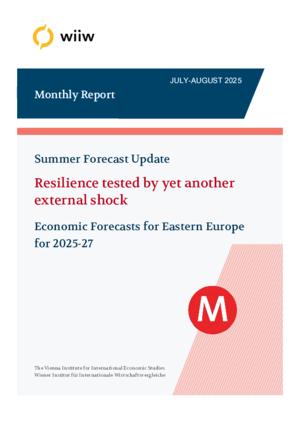Monthly Report No. 7-8/2025
Vasily Astrov, Alexandra Bykova, Selena Duraković, Meryem Gökten, Richard Grieveson, Maciej Grodzicki, Ioannis Gutzianas, Doris Hanzl-Weiss, Gabor Hunya, Branimir Jovanović, Niko Korpar, Dzmitry Kruk, Sebastian Leitner, Isilda Mara, Emilia Penkova-Pearson, Olga Pindyuk, Sandor Richter, Marko Sošić, Bernd Christoph Ströhm and Maryna Tverdostup
wiiw Monthly Report No. 7-8, July-August 2025
38 pages including 5 Tables and 3 Figures
OVERVIEW 2023-2024 AND OUTLOOK 2025-2027
Premium Members only
Summary of key recent macroeconomic data for CESEE, and overview of new wiiw forecasts for 2025-2027 (Excel file)
Summer Forecast Update
Resilience tested by yet another external shock
Economic Forecasts for Eastern Europe for 2025-27
The summer 2025 economic outlook for Central, East and Southeast Europe (CESEE) remains broadly resilient, despite yet another external shock – the outbreak of conflict between Israel and Iran. While the potential for oil price spikes and global growth slowdowns exists, the region has consistently demonstrated strength in the midst of crisis, from the COVID-19 pandemic to the war in Ukraine. CESEE is forecast to grow faster than the euro area, helped along by domestic demand, strong real wage growth and robust investment. However, fiscal pressures are mounting, especially in those EU-CEE countries with a high deficit and looming consolidation needs. Political instability, both domestically and globally, adds to the risk, while the long-term outlook hinges on German industrial recovery, the evolution of global trade dynamics and the trajectory of US foreign policy.
Global outlook: War in the Middle East will have limited fallout for CESEE by Richard Grieveson
Regional outlook: Downward revisions, but still resilient; fiscal challenges looming by Richard Grieveson
Country updates:
- Albania: FDI inflows and tourism remain key to sustaining growth momentum by Isilda Mara
- Belarus: Authorities struggle to counter slowdown in growth by Dzmitry Kruk
- Bosnia and Herzegovina: Modest economic growth amidst sticky inflation by Selena Duraković
- Bulgaria: Euro adoption now well on track by Emilia Penkova-Pearson
- Croatia: Growth momentum slows amid global and domestic headwinds by Bernd Christoph Ströhm
- Czechia: Guarded optimism in uncertain times by Ioannis Gutzianas
- Estonia: Acceleration in growth ahead, amid challenges by Maryna Tverdostup
- Hungary: So far from a ‘flying start’ – the stumbling continues by Sándor Richter
- Kazakhstan: Resilient to external and domestic headwinds by Alexandra Bykova
- Kosovo: Solid growth, despite delayed government formation by Isilda Mara
- Latvia: Revival in a time of rising insecurity by Sebastian Leitner
- Lithuania: Defence expenditure helping to maintain a high rate of growth by Sebastian Leitner
- Moldova: Stagnation ahead by Gábor Hunya
- Montenegro: Downturn in tourism threatens fragile growth by Marko Sošić
- North Macedonia: Better than expected, but still far from good by Branimir Jovanović
- Poland: Growth holds steady by Maciej Grodzicki
- Romania: New government to implement austerity measures by Gábor Hunya
- Russia: Tight monetary policy taking its toll on the real economy by Vasily Astrov
- Serbia: The slow turn of the tide by Branimir Jovanović
- Slovakia: Uncertainty weighing on growth prospects by Doris Hanzl-Weiss
- Slovenia: Early signs point to a year of lacklustre growth by Niko Korpar
- Turkey: Weakening economic activity and deepening political unrest by Meryem Gökten
- Ukraine: Facing increasing headwinds by Olga Pindyuk
Reference to wiiw databases: wiiw Annual Database, wiiw Monthly Database, wiiw FDI Database
Keywords: CESEE, economic forecast, Central and Eastern Europe, Western Balkans, EU, euro area, CIS, economic growth, inflation, monetary policy, fiscal policy, GDP, wages, fiscal balance, policy rate, political risk
JEL classification: E20, E21, E23, E24, E31, E5, E62, H60, J20, J30, O47, O52, O57, P24, P27, P52
Countries covered: Albania, Belarus, Bosnia and Herzegovina, Bulgaria, CESEE, CIS, Croatia, Czechia, Estonia, EU-CEE, Euro Area, Germany, Hungary, Kazakhstan, Kosovo, Latvia, Lithuania, Moldova, Montenegro, North Macedonia, Poland, Romania, Russia, Serbia, Slovakia, Slovenia, Turkey, Ukraine, Western Balkans
Research Areas: Macroeconomic Analysis and Policy
